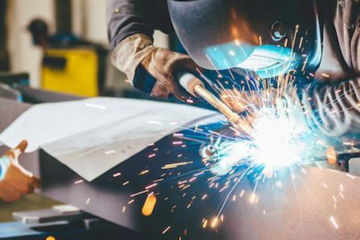In our everyday lives, we rely heavily on structural steel and its related products. It is used in railways, bridges, stairs, high-rise buildings, and many other applications that require long-term firmness and strength. Structural steel is an ideal material for construction since it has exceptional strength and toughness which is not the case with other metals and their alloys.
Nowadays, several structural steel-based products are used in construction. These include skids, pipe racks, ladders, and bar joists to name just a few.
Here is all you need to know about structural steel fabrication and its types
What is Structural Steel Fabrication?
It is a process wherein raw steel is converted using bending, cutting, and modelling into items that can be used in many applications including construction, machinery, aerospace, and consumer products.
The process of structural steel fabrication involves the use of drills, lathes, and mills to remove impurities from steel and to change its shape, size, and dimensions to meet your construction requirements.
Steps Involved in Structural Steel Fabrication
Here are the main steps involved in the Structural Steel Fabrication Process:
Design Creation
In this step, the experts look at the design requirements and then create a structural steel design that will fit your project. The designs can either be made by hand or using a dedicated computer program.
Acquiring Raw Material
At this stage, you need to acquire raw steel and other materials and tools needed for the fabrication. Make sure to acquire these materials from a well-reputed structural steel supplier that guarantees the best results.
Cutting and Drilling
After that, a CNC-based cutting machine is used to cut the steel according to the design and then drilled to make the holes so that you can use it at the right location. For cutting purposes, saw machines, waterjet machines, laser, and plasma cutting tools are used. The most common cutting methods include shear cutting, abrasion, and wedge action cutting.
Bending or Welding
After cutting and drilling you might also need to bend the steel so that it fits perfectly in its place. For bending you can use plate, roll, section, and tube bending methods. After bending the steel is welded using MMA or MAG welding tools.
Quality Check
After fabrication of the structural steel, it is inspected using various mechanical tests and dimensional analysis. NBT or non-destructive testing can also be used to unveil defects in the welded structural steel.
Finishing
After the quality check, steel is sandblasted and then painted to get the desired output. The paint protects the steel from corrosion thus increasing its lifespan.
The Types of Structural Steel Fabrication
Following is a brief overview of the main types of structural steel fabrication processes:
Cutting
This is the most common structural steel fabrication type that finds numerous applications across many disciplines. Cutting can be done manually, using a powered tool, or a computerized technology.
Bonding
As the name suggests, this technique joins two different steel pieces together. The hot and cold cure adhesive approach is mostly used to bond different structural steel components. It gives you a wide range of shapes that you can manipulate and modify based on your needs.
Folding
In this process, a steel piece is folded into different shapes with the help of a brake press. You can also manually hammer a steel slab to get any desired shape that is suitable for your current application.
Extrusion
This process is used for the fabrication of pipes and other cylindrical shapes. In this process, a customized die is used to create a cavity inside a steel pip which is further used in construction.
Punching
In this process, a piece of structural steel is drilled to create holes. The pieces thus prepared can be used for fastening purposes.
Main Structural Steel Fabrication Designs
Flat Bars
This all-around and flexible structural steel product has applications in wall claddings, panelling, and decorative implants. These are usually made from mild, low-carbon steel, making it very easy to cut and transform into other required shapes.
Circular Hollow Sections
These circular tubes have a hollow cross-section, uniform wall thickness, and a much superior torsion resistance. The design of this structural steel makes it useful in multi-axis loading processes. It finds applications in a variety of fields including, petrochemical structures, cranes, agriculture, railings, etc.
Parallel Flange Channels
This structural steel has flanges which are extending rims attached to a flat section. This type of steel is used in cases where you need greater load capacity or an even weight distribution.
Parallel flanges usually come in U or C shape with right-angled corners. The shape and composition impart this steel a very high strength-to-weight ratio making it suitable for building frameworks, beams, and wall studs.
Tapered Flange Beams
These flanges have less thickness on one end and are mostly used to support other beams. This structural steel usually comes in an I shape whose size can vary based on the application.
These flanges don’t possess a very high resistance ratio which means you have to combine them with other structural steel components to get the best results.
Angled Sections
These are usually in the shape of the letter L. They are used in bed frames, ladders, and different types of furniture. Angled sections not only give your structures more strength but they are also quite low-expense which makes them ideal for construction purposes.
These sections when secured in their place with nails, nuts, and bolts give you a much greater resistance against impacts thus enhancing the stability of your structures.
Conclusion
Different applications require different types of structural steel and that is why it is important to familiarize yourself with different structural steel fabrication types and designs.
Structural steel is a useful material due to its high durability, corrosion resistance, affordability, and high strength-to-weight ratio. Due to these attractive features, it finds applications in construction, transportation, automotive industry, mining, energy, and agriculture.
If you make structural steel a key part of your next construction project, we assure you that you will find the results extremely superior to the alternative solutions. You can visit PSI to discover premium quality structural steel works for use in your construction, power plants, oil and gas, and any other heavy and medium manufacturing industries.


